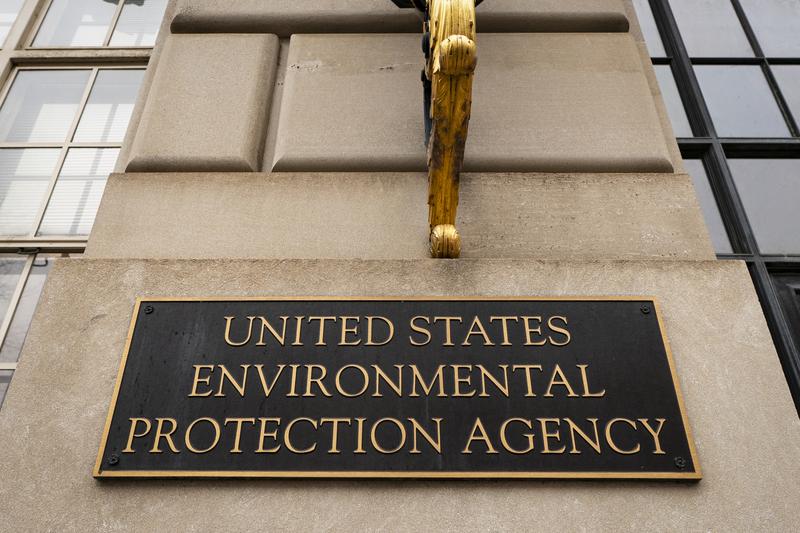Trump's EPA Takes Aim at Climate Regulation

( Al Drago / Getty Images )
[MUSIC]
Brian Lehrer: Brian Lehrer on WNYC. We continue with our Health & Climate Tuesdays section now. We did the RFK-related health angles in Part 1. Now we move to the climate track. Today, we'll discuss one big specific assault on climate policy that is being considered by the Trump administration and not getting top-line attention going all the way back to an official finding in 2009 that climate change threatens human health. They may cancel that finding to make it easier to undo many pollution regulations.
The Environmental Defense Fund, that environmental group, yesterday filed a lawsuit seeking access to any records the Trump administration is producing. For example, that would include, I guess, any actual science that they might be citing to claim climate change does not threaten human health or other records that they're generating before they actually rescind the 2009 human health endangerment from global warming findings.
We'll explain the politics and implications of that now with Naveena Sadasivam, senior staff writer at Grist, which covers climate issues closely. Her article on this has these words in the headline, Trump's EPA Wants to Demolish the Bedrock of US Climate Regulations. Naveena, thanks for giving us some time today. Welcome to WNYC.
Naveena Sadasivam: Thanks for having me, Brian.
Brian Lehrer: Your article begins with a landmark climate-related Supreme Court ruling from 2007. What did the Supreme Court rule in 2007?
Naveena Sadasivam: Yes, absolutely. In 2007, the Supreme Court found in Massachusetts v. EPA that the Clean Air Act did include greenhouse gases as air pollutants. The question that was brought before the court was whether greenhouse gases like carbon dioxide and methane were technically considered "air pollutants" under the Clean Air Act. The Supreme Court ruled that there was sufficient evidence to find that greenhouse gases like carbon dioxide were endangering human health and so they could be considered air pollutants. That was partly one of the findings.
The Supreme Court also then directed the EPA to conduct its own investigation into whether greenhouse gases were endangering public health, and it directed the agency to do so. That is what led to the endangerment finding.
Brian Lehrer: That was big, right, that greenhouse gas emissions could be considered pollution under the existing clean air laws. They didn't need a new act of Congress to begin to issue regulations, but first, they had to determine that global warming is an actual threat to human health. Two years later, in 2009, the EPA announced this bedrock finding called the endangerment finding. What was the endangerment finding?
Naveena Sadasivam: The endangerment finding essentially was the EPA looking at the body of scientific evidence out there at the time and determining that continuing pollution, continuing emissions of carbon dioxide, methane, other greenhouse gases was having an effect on the planet and on public health. It found that these gases were endangering human health and that it essentially needed to be regulated.
Brian Lehrer: You know what I did this morning, Naveena? I went into the actual 2009 endangerment finding document. It's right there. They haven't wiped it off of the EPA website yet. For all the climate reporting and conversations we've had on this show, I've never looked at this document before. I'll read just a little bit here for our listeners, just from the table of contents, to give everyone an idea of how they listed and categorized multiple potential human health effects of a warming planet.
Big four categories: temperature effects, extreme events, climate-sensitive diseases, and aeroallergies. Then you go down and they get into particular ones, and some of the ones, wildfire and drought risk. This was 2009. We've been talking so much more about these things as there have been obviously the bigger wildfires this year than in the past, bigger droughts elsewhere. Another category, sea level rise and coastal areas, vulnerable areas. We know what's been happening in some of those.
Those are just a few examples from the table of contents. Then if you read into it, they get into all the particulars and things that could happen as a result. Anything you want to add to what the finding enumerated in terms of risks to human health?
Naveena Sadasivam: Yes. One thing I would point out is, and you alluded to this, these were the findings all the way back in 2009. That body of evidence has only grown over the years. Today, researchers have the ability to look at a specific wildfire or hurricane or extreme weather event and determine the extent to which climate change contributed to that event. That's not an ability that researchers really had back in 2009. The evidence has only grown, and the effects that we're seeing are only increasing on a daily basis.
Brian Lehrer: Yes. You have, since the original finding, listed mostly ranges of risks for various humans, health effects from climate change that could come about, keeping that data that you were just referring to of actual effects over the years, and undoing the finding of endangerment based on that would be a good thing. I don't mean undoing it would be a good thing. I mean keeping the data would be a good thing from a standpoint of science and policy. Yet, you have another article that's all about risks to access to the data. You want to talk about that one?
Naveena Sadasivam: Yes, absolutely. One of the things that we've seen over the last month is that the Trump administration has been taking down key resources that researchers depend on. One example is an environmental justice scorecard that looked at the extent to which specific neighborhoods were affected by things like historical redlining, the extent to which there are differences in air pollution, for instance, from neighborhood to neighborhood.
This was a scorecard that was being used by communities across the country, and it was also being used by agencies to guide their decision-making. That tool has been taken down. We're seeing that the Trump administration is also scrubbing references to climate change, scrubbing references to diversity and equity efforts within the EPA and within other climate science agencies like NOAA, and we're also seeing mass firings. The combined effect is that it essentially limits researchers' ability to use data that the federal government has collected over years.
Now, the one saving grace I will say is that there are archivists who are doing an excellent job of making a copy of all of that data and hosting it separately so that it isn't lost forever. It just goes to show you the administration's assault on climate change, on climate data.
Brian Lehrer: Is this an example of the assault on DEI coming out the other end as kind of a backdoor assault on climate policy because they don't want to look at environmental justice issues anymore, the kind of thing that you were just referring to, where certain low-income neighborhoods, which tend to be neighborhoods where people of color live through the history of redlining or other factors, have become more vulnerable?
The people who live in those neighborhoods have become more vulnerable, and the data would bear this out to human health effects from climate change. They don't even want to measure by race anymore, so they're not looking at that. Is that overstating it?
Naveena Sadasivam: I don't get the sense that there's been that level of thought. It does seem like at this stage, the Trump administration is going in with a sledgehammer, essentially, and any programs that mention diversity or equity are getting cut or taken down. This is true even in terms of the contracts that have been signed with environmental groups, with nonprofits, with community groups, with private entities who are doing work on the ground that might be related to environmental justice.
Brian Lehrer: Getting back to the original 2009 endangerment finding, from that, as your article reminds us, flowed rules limiting tailpipe emissions during the Obama and Biden administrations, what are some of the most important emissions rules that they enacted based on this 2009 finding at the EPA that global warming can endanger human health?
Naveena Sadasivam: Right. As you said, immediately after that endangerment finding, the first set of rules that flowed from it were related to tailpipe emissions from cars and other vehicles. There are rules regulating the amount of emissions from coal plants and other power plants. That's one very significant rule, emissions from aircrafts and a whole range of other industrial sources as well. The endangerment finding essentially underpins a number of rules and regulations that have to do with carbon emissions, methane emissions, greenhouse gases in general.
Brian Lehrer: Your article refers to a Heritage Foundation recommendation to update the endangerment finding. Heritage Foundation, many of our listeners know is who produced the Project 2025 policy blueprint last year. Was this in Project 2025 per se, if you know, undoing the endangerment finding?
Naveena Sadasivam: In Project 2025, there's language suggesting that the Trump administration should look into establishing a system to "update" the 2009 endangerment finding. I haven't seen reference specifically to undoing it completely, but there is a long history of conservative groups and climate skeptics trying to dismantle the endangerment finding because I think it's well understood that it is what underpins so many of these carbon regulations. There have been previous efforts too to try to do that.
During the previous Trump administration, during Trump's first term, a number of groups went to the EPA and petitioned the agency to reconsider the endangerment finding, thinking that there was a favorable administration in office and that the agency might consider doing that. Over the four years, the agency did not take up the petition, and in the last week of the administration, the agency's secretary, Secretary Andrew Wheeler at the time, essentially wrote back to the groups and said, "Hey, we're not going to do this. We're not undoing the endangerment finding [crosstalk]."
Brian Lehrer: You mean during the first Trump administration?
Naveena Sadasivam: Correct. Yes, during the first Trump administration.
Brian Lehrer: Is there even any made-up claim that you can imagine under which Trump or EPA, under their new chief Lee Zeldin, might argue that climate warming has not had actual human health effects since the reporting from the Washington Post that started a lot of these conversations is that Zeldin is recommending to Trump that they undo the endangerment finding?
Naveena Sadasivam: Correct. We don't know exactly what that recommendation is based on. When you look at the way climate skeptics center their arguments, I suppose it's always possible to cherry-pick evidence and make the claim that climate warming is perhaps part of natural changes that have been taking place for millennia. That argument certainly exists. It has no merit, of course, but I don't want to speculate on what might be in that recommendation.
Brian Lehrer: The last thing, in your article, you also say it won't be easy to undo the endangerment finding. Why not?
Naveena Sadasivam: Yes, absolutely. This is something that I heard repeatedly from legal experts that it'll be extremely, extremely difficult to undo the endangerment finding. That was part of the reason why President Trump in his first term didn't pursue that avenue. Firstly, just as we discussed earlier, the amount of evidence finding that climate change is having an effect on public health is just staggering at this point. Then there's also the fact that in 2022, Congress, when it passed the Inflation Reduction Act, did include some provisions that called out greenhouse gases as air pollutants.
It is now part of law, part of legislation that Congress has passed. Then there's also just a ton of case law. Since that 2007 Supreme Court case, there have been multiple times when various courts have looked at this question of whether greenhouse gases are, in fact, air pollutants, and they have found that, in fact, that is the case. There's just a vast body of law that backs up that finding.
Brian Lehrer: Of course, they haven't seemed to care about a lot of other rules or laws and other things they've been setting out to break, so we'll see how much what you just laid out stops them in this case. We leave that there for today. That is our Health & Climate Tuesdays section of the show for this week. We thank Naveena Sadasivam, senior staff writer at Grist, which covers climate issues closely. Her article on this is called Trump's EPA Wants to Demolish the Bedrock of US Climate Regulations. Thank you so much for joining us with your reporting.
Naveena Sadasivam: Thanks, Brian.
Copyright © 2025 New York Public Radio. All rights reserved. Visit our website terms of use at www.wnyc.org for further information.
New York Public Radio transcripts are created on a rush deadline, often by contractors. This text may not be in its final form and may be updated or revised in the future. Accuracy and availability may vary. The authoritative record of New York Public Radio’s programming is the audio record.

